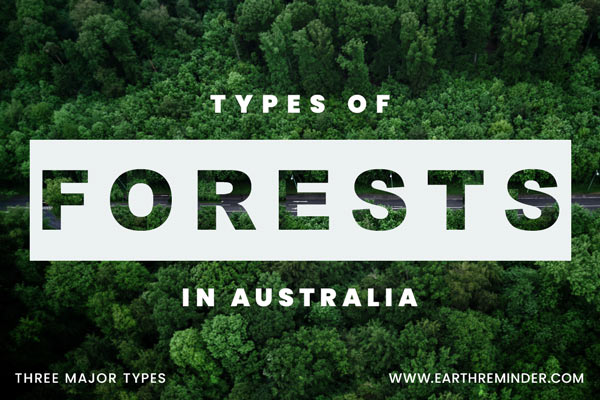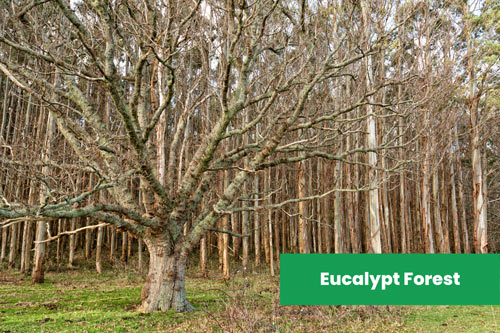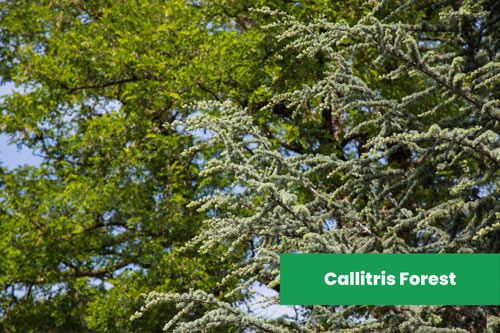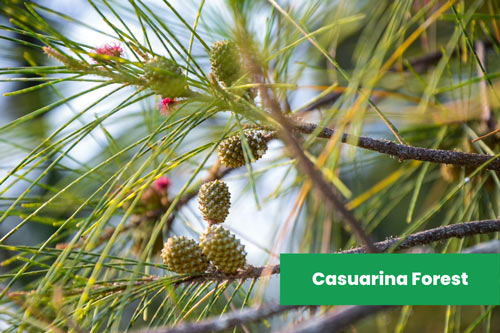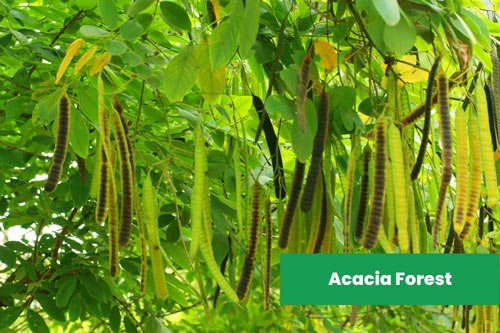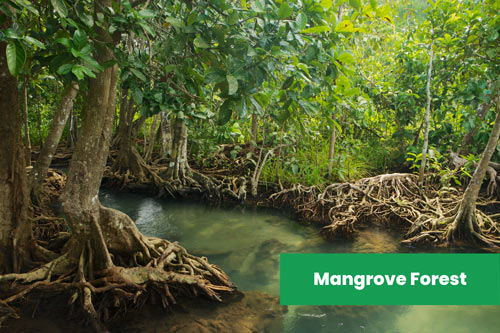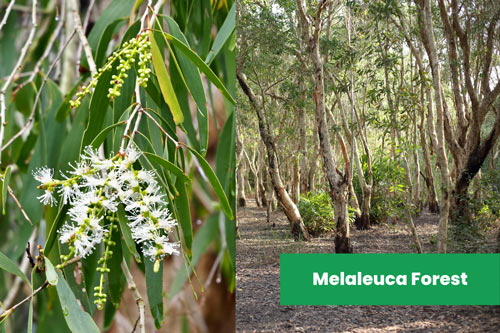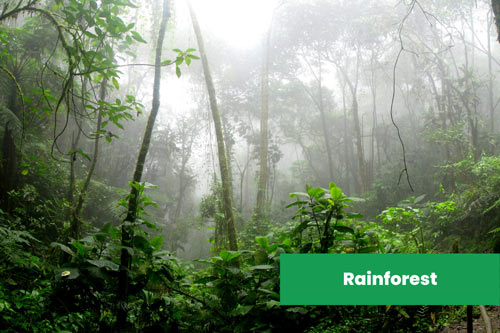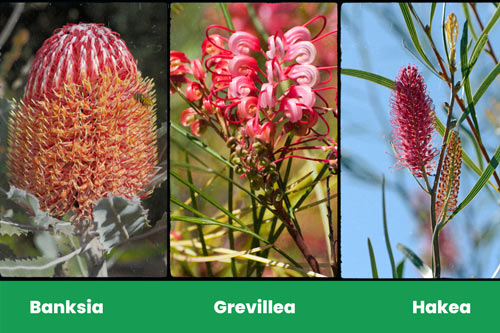Types of Forests in Australia
If you ever planned to visit Australia, there might be one reason – the forests and biodiversity. Yet, you might wonder how many types of forests there are in Australia? In this article, we will answer it for you.
Australia is well known for its vast diversity of forests, which benefits the environment and the economy. Further, it is one of the greatest assets of the entire world.
According to the Forests Australia website, Australian forests cover about 17% of the total land area of that region; This is about 134 million hectares. Also, you will be amazed to know that Australia has the seventh-largest forest area of all.
Queensland itself embeds over 37% of the total Australian forest area and accounts for the largest forest in Australia.
Australia’s forests have high commercial values for all the species available there, which comprises many endangered species. Furthermore, it is responsible for providing wood and non-wood products, drinking water, soil, recreational and tourism purposes, and culture and heritage to the local community.
Overall, it’s highly crucial to understand the types of forests in Australia so that we can take action towards preserving them.
Table of Contents
What Types of Forests Are in Australia?
As per Australia’s state of forest report 2018, we can categorize the forests in Australia into three major types: native forests, commercial plantations, and other forests.
Native Forests in Australia
Native forests cover over 98% of the forest area in Australia, which is about 132 million hectares. Here are the eight types of native forests in Australia that you must know.
Eucalypt Forest
As per the last state of Australia’s forest report, Eucalypt forests are Australia’s most common forest type. These forests embed about 77% of Australia’s total native forest region.
Angophora, Corymbia, and Eucalyptus these three trees are the most abundant genera in the Eucalypt forests. Most of the eucalypt species keep their color green throughout the year.
As per studies, the genus present in Eucalypt forests is adopted from rainforests and carries characteristics to prevent wildfire situations.
Such forests are omnipresent in Australia but mostly in the driest conditions. The distribution of eucalypt forests are as such:
- 35 million hectares (35% of total availability) are present in Queensland,
- 20% (20 million hectares) in Northern Territory,
- 32% (about 32 million hectares) on private lands,
- 32% on leasehold lands and a further 18% are present in nature conservation reserves.
Some of the benefits Eucalypt forests provide to Australia are;
- It protects biodiversity by supporting several exclusive flora and fauna.
- All parts of these trees have been used traditionally for medication, adhesive, creating goods, utensils, and equipment.
- An enormous source of wood for the construction of buildings, creating furniture, and other wood products like boards and floors.
- The oil from the leaves has a great purpose in synthesizing perfumes and is utilized in aromatherapy.
Callitris Forest
About 1.5% of Australia’s total native forests include Callitris forests. This is about 2.0 million hectares.
Callitris plants are exclusive to Australia and New Caledonia. Out of 15 species of Callitris, you can see 13 different species in Australia.
Due to their resemblance with Northern hemisphere Cypress trees, Callitris is commonly known as Cypress. However, these are not true pines.
New South Wales is the region that covers about 69% of such forest, and a further 0.7 million hectares are present in leasehold lands, and about 35% of private areas cover these forests.
Most of the Callitris trees are of medium height. And these forest types are primarily open forests rather than woodland forests.
Some of the uses of Callitris plants are as follows:
- It is used for flooring, making weatherboards, lining boards, interior joinery, cabinets, etc.
- Some species have woods that are resistant to insects.
- The resin from these trees is traditionally utilized as adhesive to traditionally attach different tools and spears.
Casuarina Forest
The name Casuarina is given to such types of forests because the major trees in these forests are either Casuarina or Allocasuarina. Six species of Casuarina and 59 species of Allocasuarina are seen in these forests.
Casuarina is commonly known as Sheoaks; This is due to their alikeness with European oaks. Such forests are typical in some coastal or riverine regions of Australia.
The primary appearance of Casuarina forests is low in height. Further, the most abundant species of Casuarina forests include desert oak (Allocasuarina decaisneana), belah (Casuarina cristata), and river sheoak (C. cunninghamiana).
There are 1.2 million hectares of Casuarina forests in Australia (0.9% of total native forest area). Out of the entire occurrence, about 41% is present in New south wales. Further, 22% of Casuarina forests cover Queensland Island.
The benefits Casuarina forests provide are;
- It can fixate nitrogen with the presence of symbiotic bacteria in its roots.
- It helps to stabilize the river banks through their roots.
- Further, it works to maintain water quality.
- Timbers are used as cabinets.
Acacia Forest
The second most common type of native forest in Australia is Acacia.
About 10.8 million hectares of Acacia Forest total account for 8.2% of the total native forest area. Here you can see 1000 different species of Acacia plants.
Further, Queensland covers about 47% of Acacia Forest, and you can see 30% of such forests in Western Australia.
Some commonly known Acacia species include Mungla (Acacia aneura), Brigalow (Acacia harpophylla), Blackwood (Acacia melanoxylon), and silver wattle (Acacia dealbata).
The former two are well-seen in central Australia and the Queensland and northern New Wales areas, respectively. Blackwood and Silver Wattle are the species that rise in wetter regions like Tasmania and Western Victoria.
If we talk about the forest structure, both woodland and low forest types of Acacia plants account for 8.5 million hectares.
Some benefits of Acacia plants in these regions are;
- They help in fixing nitrogen to improve plant growth through the root bacteria rhizobia.
- Prevents soil erosion.
- Quick to regenerate after bushfire-like disasters.
- Acacia woods are commercially used for building cabinets and furniture.
- Also, we can recognize them as the most attractive flowering plant that is utilized in floral arrangements.
- It is also used as food materials for cattle during food scarcity periods.
Mangrove Forest
The Mainland States and northern territory are where Mangrove forests are abundantly present. Out of the total Mangrove forests, Queensland has about 0.4 million hectares, and the northern territory covers only 39% of such forests.
Australia is the house of 41 species of Mangrove plants. You can easily detect mangroves on intertidal zones of subtropical, tropical, or temperate coastal and bay regions with their root characteristics.
If we talk about the forest structure, 49% of Mangrove forests are of closed types. Furthermore, 0.1 million hectares of spread forests have low-height plants.
Out of the total native forests, only 1% area covers mangrove forests but is widely essential.
Some benefits include;
- Environmental benefits on estuarine and coastal ecosystems.
- Works as buffer zones against storms and cyclones and prevents erosion.
- Serves as food for migratory birds, coastal and estuarine pieces, crustaceans, and mollusks.
- Further, act as nurseries for several aquatic animals.
- Provide food to the coastal communities.
- From ancient times, people used the wood from mangrove trees to make weapons, paddles, and shields.
Melaleuca Forest
Out of 200 species, most plants in Melaleuca forests are exclusive to Australia. Taller Melaleuca plants have a commonly known name: Tee trees or Paperbacks.
Some Abundant species include Melaleuca viridiflora (broad-leaved paperbark) and Melaleuca leucadendron (weeping paperbark). Cape York peninsula inside Queensland (5.1 million hectares) and the northern part of the northern territory (1.0 million hectares) are the primary spots for Melaleuca forests.
We can further find these forests on the east coast of Mainland Australia and north-western Tasmania. Forest structure is mainly low woodland forests.
Some Benefits of Melaleuca forests are;
- Provides food and habitat for various aquatic species.
- Works to filter water and retain its purity.
- Prevents soil erosion and sediment runoff.
- Serves as a house for several species of birds.
- Foliage provides tea tree oil, one of the primary essential oils with antibacterial and germicidal properties.
- Woods are durable in water and can resist termite attacks.
Rainforests
Out of all the native forest types of Australia, Rainforest is embedded in over 3.6 million hectares of the region. Apart from South Australia, all other states of Australia have rainforests. Queensland contains 55% (2.0 million hectares) of Rainforest native types. Further, Tasmania is the region for 0.7 million hectares of such forests.
You can characterize rainforests from their closed canopy, lush growth, and high rainfall. They rarely catch wildfires and are resistant to shade when young. This helps these trees to fight against extreme situations like lightning strikes, thunderstorms, and cyclones.
Moreover, Rainforests are widely significant for sustaining the different types of flora and fauna species. Medium-height plants dominate the rainforests.
A few significances of Australian rainforests include;
- Conserving the biodiversity of the continent, providing a home to several forest-dwindling species.
- Habitat to various threatened and endemic species.
- Have natural beauty and aesthetic importance.
- Serves as a primary spot for ecotourism and provides economic benefits.
Other Native Forests
There are some other types of native forests. The primary genus of these types of forests is Atalaya, Agonis, Hakea, Banksia, Lophostemon, Grevillea, Heterodendron, Leptospermum, and Syncarpia. Further, some other types are yet to be discovered.
Commercial Plantation Forests
There are about 1.95 million hectares of such forests in Australia. Inside the commercial plantation type, there is the occurrence of softwood and hardwood plants. The primary reason for such types of forests in Australia is commercial usage.
Other Forests
Moreover, about 0.47 million hectares of forest area come under the “others” category, including non-commercial and other types of forests.
Conclusion
Forests are the most significant assets in every continent. There is a solid reason for that. They provide us with pure oxygen, food, and goods that we use regularly and help us grow our economy. Further, forests are the central place for living for the wild species of animals.
The different types of forests present in Australia serve the planet in several ways. However, they also suffer through the effects of increased demand and population. The wildfires, mining activities, removal of forests to create space for people, and chopping them to make our lives more comfortable are some examples of how our forest resources are decreasing gradually.
Therefore, we must understand the benefits of such forests and work towards their preservation.
